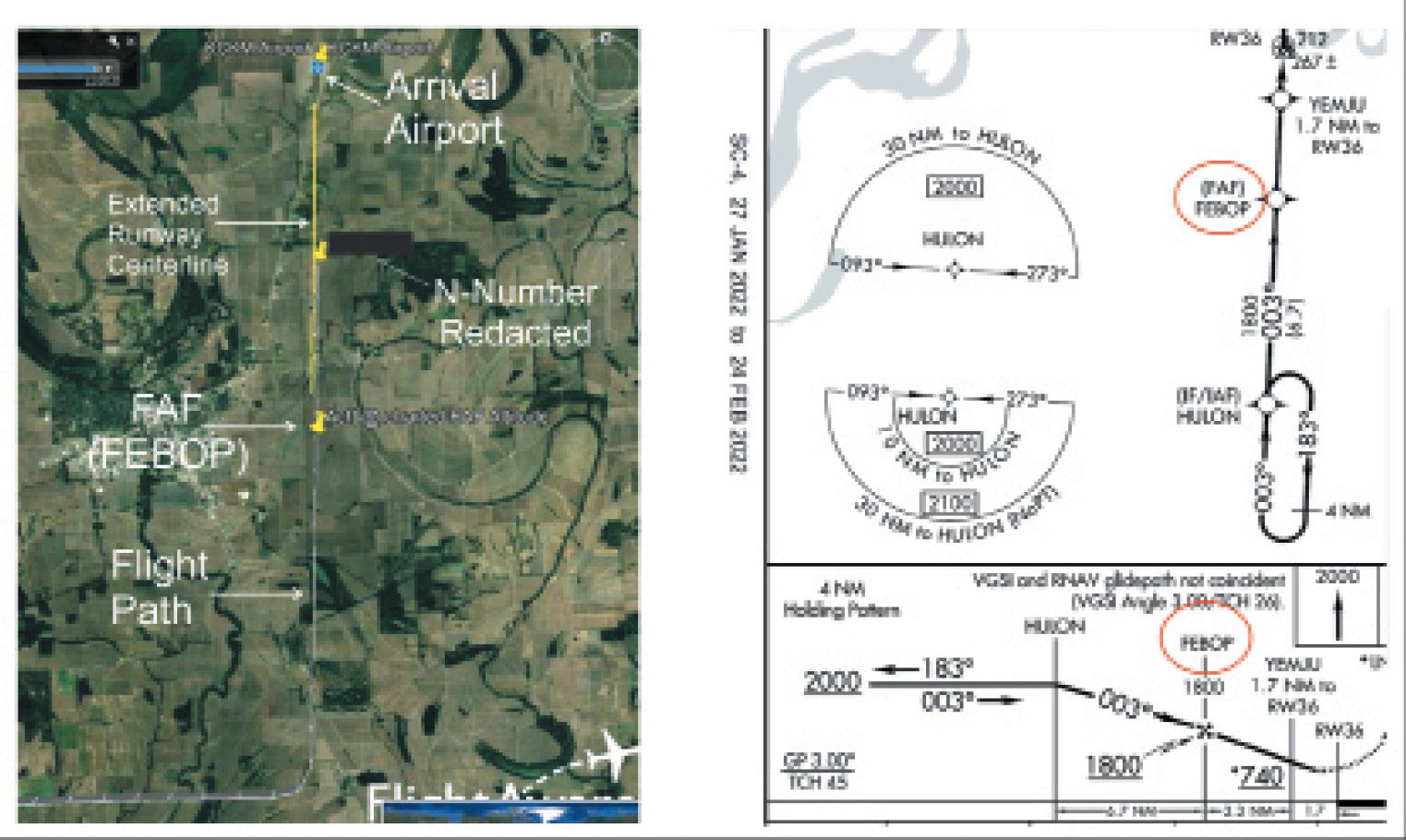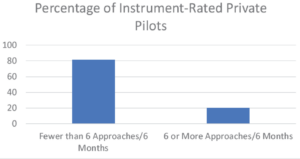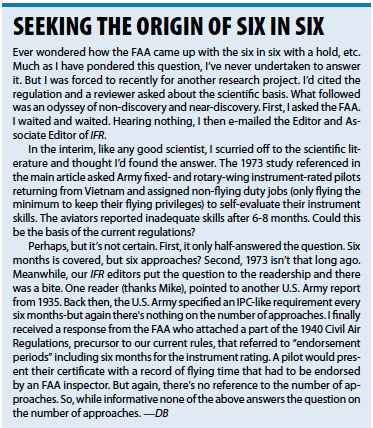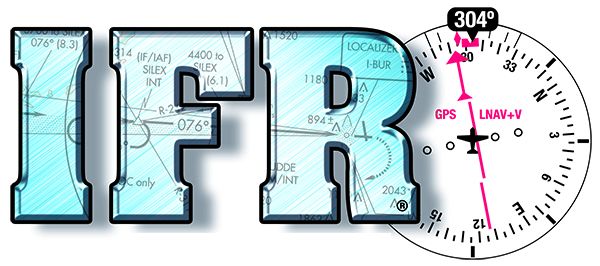Instrument pilots know that IMC is challenging and far less forgiving than flying visually. Proficient flying by instruments is a must for us lest we enter the NTSB annals. When the ink on our instrument tickets was still wet, our skills were ultra-sharp. But as time passed, without continued practice those instrument skills slowly atrophied.
Let’s face it: Visual conditions are more common than instrument weather and getting in those approaches on a regular basis becomes more difficult. Yet, to legally file IFR, the feds require the old six in six and more. We’re often told that legally current and proficient aren’t synonyms so we should seek the latter. Like any skill, “use it or lose it,” applies. For those who skimped on practice, did they restrict flying to common short hops for the proverbial $100 hamburger in CAVU or blast off into IMC?
One Embry Riddle Aeronautical University (ERAU) researcher sought to answer these questions. I’ll get to the findings in a bit, and wrap up discussing the concept of “goal seduction” which perhaps, too often, causes the feckless pilot to cast off the shackles of his/her personal minimums. Don’t worry; I’ll “translate” these recent research papers into non-scientist pilot-lingo, avoiding the scientific mumbo jumbo that probably rivals Ambien as a sleep aid.
Instrument Pilot IMC Accidents
The glossy flying magazines tout improved general aviation safety over the last few decades. I have no quibbles with that statement but it’s too broad. Dig a little deeper into accidents in IMC by instrument-rated private pilots—more relevant to us—and the story is not so rosy. The rate of such accidents across the U.S. hasn’t decreased during 2010-2019 according to one of those research studies. Remember too that IMC accidents are two to three times more likely to end with some family invoking a life insurance policy versus a mishap in visual conditions. That higher proportion of fatal accidents is also unchanged over the last decade.

Presumably the ERAU researcher was seeking reasons for this not-too-upbeat picture. Could it be a lack of proficiency in flying instruments? Yup, we all know that any skill set will become dull over time if not exercised. For an unrelated example, a study of ophthalmologists in the U.K. looked at their proficiency in cataract operations after a COVID-19-related hiatus. Between a third and a half of the docs reported transient anxiety and reduced confidence.
More relevant to keeping the sunny side up in instrument conditions was an Army study that harked back to 1973. The researchers studied fixed- and rotary-wing pilots assigned desk jobs (flying only the minimum amount to maintain flying status). The pilots self-reported less than adequate instrument skills after eight months of limited flying. Primed with this information, our ERAU prof decided to take on the task of finding out how frequently instrument-rated pilots shoot approaches to keep instrument skills from fading.
Who? Where? How?
The study examined Bonanzas, Cirrus SR20/22s, Mooney M20s, Cessna 182/210s, and Piper PA28/32s, all individually registered in Texas and owned by pilots holding private certificates with an instrument rating. Corporate ownership was excluded. Why those particular aircraft? The argument was that these are common among pilots after casting off the training wheels (Cessna 172s and the like). Why Texas? Two reasons: The official one was that this was the state with the most registered general aviation aircraft. The unofficial reason was that the researcher resides in that state.
How were flights of these aircraft tracked to assess whether an approach was undertaken? Figuring that all aircraft in a Mode C veil have to be ADS-B-out equipped, the study zeroed in on only those airplanes registered in the corresponding areas. The researcher then cranked up FlightAware to track the aircraft using their publicly available ADS-B data (no flight plan was needed) for the six months spanning fall 2020 through spring of 2021. There were a lot of flights—1684 for 106 planes.
Fine, but how to count an approach? As in any scientific pursuit, precision is a must: The aircraft had to pass within 0.3 NM of the FAF at within 300 feet of the charted final approach fix altitude with the airplane descending thereafter to at least the circling altitude.
And the Answer Is…
Did our Stetson-donning aviators complete six in-flight approaches in six months? Okay, before you fill my inbox about counting and logging approaches hold your horses—I’ll get to that later. Let’s start with the good news. There were indeed some super-achievers completing well north of 13 approaches over the half year in which flights were tracked.
The not-so-good news was that these were by far the minority, making up only seven percent of the “lab rats.” In fact, only 20 percent of the aircraft (all in single-pilot ownership, remember) completed six or more in-flight approaches in as many months. Somewhat depressing was that the median point (half above, the other half below) was two approaches in six months. One point worth making (which the researcher did make) is that the study says nothing about the legal currency of the pilots. So for example, a pilot might have only shot one approach over the study period but completed five approaches just outside of the capture window.

Of course, just because an airplane is owned by a single proprietor doesn’t mean he or she is the only person flying that aircraft. True, but if this is the case, that would make the picture even more bleak. For the case(s) where an aircraft owner allowed another pilot to fly the airplane, the approach count for a single aircraft would be “diluted” by the multiple pilots.
Aviation Training Device?
Let’s look at the scenario where some pilots “topped up” their approaches in an aviation training device, ATD. Yup, the study would miss those approaches. But think about it. What are most ATDs used for? You guessed it—training. Flight schools will equip with ATDs, but they’re pretty well aimed at their customers—students—and equipped accordingly. So there will be many variations of the trusty Cessna 172, perhaps even sporting a G1000 panel, but good luck finding one set up at your local flight school for a Bonanza, Mooney, Cirrus, etc.
Even if they do, the chance of your sim’s instrument panel resembling the aircraft is nearly zero. (Our esteemed editor has echoed this sentiment more than once as part of his Cessna 340 recurrency training.)
I too carry some prejudice against the basic or even advanced aviation training devices. Level D simulators as used by the airlines faithfully recreate the instrument panel and the flight characteristics of the desired aircraft. Also, aviation training devices—even with motion—are poor at creating the sensory cues like the somatogravic illusions that can quickly get any pilot into trouble. There are other shortcomings of all sims, such as lack of full ATC and traffic. Of course, you might disagree on all this. One pilot, with whom I had a long email exchange, was adamant that flying his basic aviation training device maintained his instrument proficiency for his Cessna T206. Maybe the panels were similar.
But, why else might these pilots place a low priority on legality and proficiency? There’s no way to know. We might guess that some figure that Texas weather is good enough most of the year. Barring convection there’s some truth to that, but come fall into spring, IMC can rear its head with some regularity. Or, perhaps finding a safety pilot for practice approaches is just too difficult.
I’m Good Enough
Or, maybe these pilots just didn’t feel a need to be IFR-proficient—perhaps flying with nary a cloud in sight and/or just doing short hops for the proverbial $100 hamburger. So wondered our intrepid researcher who then matched up departure weather with those aircraft completing less than six in-flight approaches in as many months. Did our erstwhile pilots just keep their flying to clear skies? And the answer is … not all. About a quarter of aircraft, that completed less than six in-flight approaches in the six months, still blasted off into IMC or low ceilings, below 1000 and 500 feet above ground respectively. That’s at least an abundance of pilot confidence. Others might call it foolhardy.
Also, trips involving those aircraft weren’t restricted to short hops either. Half of them completed flights of 252 NM or greater. Of course, we could give the pilots the benefit of the doubt; perhaps a high-pressure system covered the entire route making for stable conditions from start to finish. Or, they might have had a Plan B for any unanticipated weather popping up along the way.
Still, we should always keep in mind that weather forecasting is anything but an exact science. As a flight briefer at a flight service station (Remember them?) quipped some two decades past, “that’s why we call it the weather—we’re not sure whether it will change.” If you can (from your own archives or from the web site), dig up the article “Better than TAF?” from the June 2019 issue of IFR. TAFs for VFR were accurate only 57 percent of the time; the flipside is that unforecast MVFR/IFR/LIFR sprung up the remaining 43 percent. You might as well toss a coin.
Also, even local flights can end up in trouble as illustrated by a fateful flight in Smyrna, Florida, a few years back. An instrument-rated commercial pilot training for an advanced certificate was doing traffic pattern work at night. The ceiling got progressively lower and she became disoriented in the clouds. The ensuing loss of aircraft control ended the young lady’s life.
Florida, a few years back. An instrument-rated commercial pilot training for an advanced certificate was doing traffic pattern work at night. The ceiling got progressively lower and she became disoriented in the clouds. The ensuing loss of aircraft control ended the young lady’s life.
Aeronautical Decision Making
Now we have to ask ourselves why pilots who didn’t seem to be legal or proficient still launched into IMC? Two other published research papers, also by ERAU faculty, might shine some light. No matter how much aeronautical decision-making is preached, humans still easily succumb to motivational pressures. In these studies, two different scenarios were created for pilots.
The first involved getting a passenger to a scheduled meeting while the ceilings were progressively decreased en route in the simulator. Nearly all pilots in the study reduced their personal minimums for the arrival airport to get their pal to the scheduled meeting on time. The second scenario was with an entertainment-oriented goal. The task-at-hand was to fly to a major sports event for which the pilot held VIP, non-refundable tickets for occupants with a free five-star hotel thrown in. Who could say no to that? But in this case, the lab rats (aka pilots in the survey) were flying a VFR-only-equipped aircraft. Like the first study, one of the weather conditions was IMC. But salivating at the thought of this big event played its dirty tricks on the pilots’ minds. Again, pilots tended to push on to their destination despite the weather. The bottom line is that we pilots tend too easily to succumb to “goal seduction.”
Wrapping Up.
Overall, instrument-rated pilots in Texas didn’t place a high priority on maintaining their in-flight instrument currency. I hope—naïvely perhaps—that aviators in parts of the U.S. more prone to inclement weather, might be more diligent in this respect. At risk of being labeled “Captain Obvious,” I’d suggest we all consider increasing approach practice. Remember too, weather is highly unpredictable and the longer the flight distance the greater the chance of crossing air masses with different characteristics or weather patterns specific to a different terrain type, like mountainous areas. Always fly safe and have a way out.





